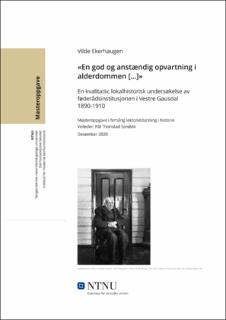| dc.contributor.advisor | Sandvik, Pål Thonstad | |
| dc.contributor.author | Ekerhaugen, Vilde | |
| dc.date.accessioned | 2021-11-24T10:31:38Z | |
| dc.date.available | 2021-11-24T10:31:38Z | |
| dc.date.issued | 2020 | |
| dc.identifier.uri | https://hdl.handle.net/11250/2831251 | |
| dc.description.abstract | Denne masteroppgava er en kvalitativ, lokalhistorisk undersøkelse av føderådsinstitusjonen i Vestre Gausdal (nåværende Gausdal kommune) i perioden 1890-1910.Føderådsinstitusjonen er kjent over hele Norge under forskjellige betegnelser: Føderåd, kår, vilkår, livaure, forlog, folga, hold, not, oppsete og andre. Som den eldste formen forpensjonsordning var føderådsordninga en viktig del av det gamle bondesamfunnet. Føderådsavtalen ble som regel inngått i forbindelse med overdragelse av fast eiendom.Tinglysing av skjøte var det som stadfesta at jordbruksenheten ble overført fra den gamleeieren til den nye husbonden, mens tinglysing av føderådskontrakt sikra den gamlehusbonden underhold. Føderådsavtalen var derfor en tosidig overenskomst om underhold tilden ene parten (føderådstakeren), mot at husbondsretten til landeiendom ble overdratt til den andre parten (føderådsyteren).
Empirien består av 39 føderådskontrakter, og oppgavas overordna problemstilling er: Hvilke bestemmelser ble gjort mellom partene i føderådskontraktene fra Vestre Gausdal i perioden1890-1910? Tre interessante underspørsmål i den forbindelse er: Hvilken avtaletype var den mest vanlige i Vestre Gausdal? På hvilken måte påvirka eiendommenes matrikkelverdi størrelsen på føderådsytelsene? Hvordan varierte ytelsenes størrelse med føderådstakernes kjønn, sivilstand og relasjon til føderådsyter? I tillegg til å undersøke problemstillinga sammenligner jeg også funna fra Vestre Gausdal med tidligere forskning.
Det snakkes gjerne om tre ulike avtaletyper i forbindelse med føderådskontrakter; brødkår, oppsett/varekår og brukende føderåd. Sistnevnte blir også kalt slepavilkår og styrekår, og innebærer en kombinasjon av vareytelser i naturalia og brukende jord. Kontrakter av typen brukende føderåd var det mest vanlige i Vestre Gausdal i perioden 1890-1910.Matrikkelskylda påvirka størrelsen på føderåda på den måten at lav matrikkelskyld ofte førte til små føderåd, mens høy matrikkelskyld førte til større og mer omfattende føderåd. Ytelsenes størrelse varierte i tillegg med føderådstakernes kjønn, sivilstand og relasjon til føderådsyter. Mens enkemenn ofte fikk de største vareytelsene, fikk ektepar oftere kontraktsfesta ulike bruksrettigheter. Nære slektskapsband var i tillegg oftere forbundet med større og mer omfattende føderådsavtaler, sammenligna med avtaler hvor partene ikke var i nær familie. | en_US |
| dc.description.abstract | This master’s thesis is a qualitative, local historical study of the Norwegian institution of “føderåd” in Vestre Gausdal between 1890 and 1910. “Føderåd” was an agreement between two parts, often between parents and one of their children. The agreement was based on the right to land in exchange for goods and favors in natura. In other words; when the land was passed on to the new owner, a written agreement was signed of both parts. In the written contract the new owner became committed to provide for the former owner until their death. There is no English term for “føderåd”, but the German language has multiple terms. The most common ones are “Leibzucht”, “Auszug” and “Alttheil”. The “føderåd” institution is known throughout Norway under various terms: “Føderåd”, “kår”, “livaure”, “forlog”, “folga”, “hold”, “not” and “oppsete”. As the oldest form of retirement pension, the institution was an important part of the old, rural society.
The empirical data consists of 39 legally valid contracts. The topic question of the study is this: What agreements were made between the parts in the contracts from Vestre Gausdal between 1890 and 1910? Interesting sub questions in that context is: What type of contract was the most common one in Vestre Gausdal? In what way did the worth of the farm affect the size of the goods and favors in natura? How did the goods and favors vary with the recipients’ sex, marital status and relation to the dispose? In addition to the study topic, I also compare the empirical findings with previous research.
There were three different types of “føderåd” contracts. The most common type of contract in Vestre Gausdal between 1890 and 1910, combined goods and favors in natura with the right to usable fields. The worth of the farm affected the size of goods and favors; small farms with low worth often gave fewer goods in smaller quantity, together with fewer favors, while bigger farms with higher worth gave a bigger number of goods in a larger quantity and a higher number of favors. The size of the goods and favors also varied with the excipients’ sex, marital status and relation to the dispose. While widowers often received the highest quantity goods, married couples more often for instance had the right to borrow a horse. The relationship between the parts also affected the content of the contract; close family relations between the parts often meant more extensive agreements, compared to cases where the parts did not have a close family relation. | en_US |
| dc.language.iso | nob | en_US |
| dc.publisher | NTNU | en_US |
| dc.title | «En god og anstændig opvartning i alderdommen [...]» - En kvalitativ, lokalhistorisk undersøkelse av føderådsinstitusjonen i Vestre Gausdal 1890-1910 | en_US |
| dc.type | Master thesis | en_US |
